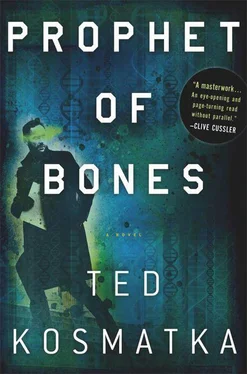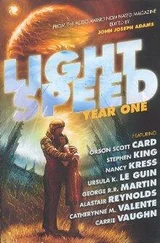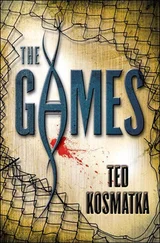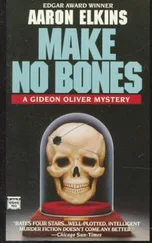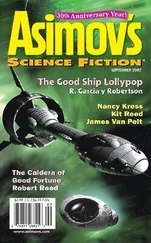Behind the stack of journals, against the wall, something caught his eye. He reached in and grabbed the green spiral notebook. He opened it, recognizing his own childish hand. His father had kept it, all these years.
He flipped the pages until he found it. Not a date, but a mouse. January-17.
He closed the notebook and threw it back into the closet.
The next day he headed back to school.
At Stanford, Paul double-majored in genetics and anthropology, taking eighteen credit hours a semester. He sat in classrooms while men in tweed jackets spun theories about Kibra and T variants, about microcephalin 1 and haplogroup D. He plowed into 300-level biology, where from the lectern his professor singled him out from the other students, responding to his question by saying, “You have the gift of insight, my boy.” And then, to Paul’s startled expression, he added, “You know which questions to ask.”
There were classes in comparative interpretation and biblical philosophy. He experimented with fruit flies and amphioxi and, while still an undergraduate, won a prestigious summer internship working under renowned geneticist Mathew Poole.
He also scrutinized the fringe theories. He contemplated balancing equilibriums and Hardy-Weinberg. But alone at night, walking the dark halls of his own head, it was the trade-offs that fascinated him most. Paul was a young man who understood trade-offs.
In the medical library, he came across research on the recently discovered Alzheimer’s gene APOE4—a gene common throughout much of the world—and he wondered how deleterious genes grew to such high frequencies. Paul discovered that although APOE4 often produced Alzheimer’s, it also protected against the cognitive consequences of early childhood malnutrition. The gene that destroys the mind at seventy saves it at seven months. He read that people with sickle-cell trait are resistant to malaria; and heterozygotes for cystic fibrosis are less susceptible to cholera; and people with type A blood survived the plague at higher frequencies than other blood types, altering forever, in a single generation, the frequency of blood types in Europe. A process, some said, now being slow-motion mimicked by Delta 32 and HIV.
In his anthropology courses, Paul was taught that all humans alive today can trace their ancestry back to Africa, to a time almost six thousand years ago when the whole of human diversity existed within a single small population. And there had been at least two dispersions out of Africa, his professors said, if not more—a genetic bottleneck that supported the Flood Theory. But each culture had its own beliefs. Muslims called it Allah. Jews, Yahweh. The science journals were careful not to specify, but they spoke of an intelligent designer—an architect, lowercase a. Though in his heart of hearts, Paul figured it all amounted to the same thing.
Paul read that they’d scanned the brains of nuns, looking for the God spot, and couldn’t find it. He examined, too, the theory of evolutionism. Although long debunked by legitimate science, adherents of evolutionism still existed, their beliefs enjoying near immortality among the fallow fields of pseudoscience, cohabitating the fringe with older belief systems like astrology, phrenology, and acupuncture. Modern evolutionists believed the various dating systems were all incorrect, and they offered an assortment of ridiculous and unscientific explanations for how the isotope tests could all be wrong.
The evolutionists ignored the geological record. They ignored the ice cores, the hermeneutics, and the wealth of biological evidence. They ignored the miracle of the placenta and the irreducible complexity of the eye.
“After all, the eye,” his anatomy professor lectured, “is biologically useful only in the sum of its parts. It can’t be reduced to functional precursor components.”
During his sophomore year, Paul got a job cleaning cages in the biology department. There were snakes and rabbits and owls, and a lonely alligator with a broken jaw—a veritable mini-zoo on the campus grounds, all of it housed in state-of-the-art facilities and cared for by a small army of lab-coated undergrads.
That first day of employment, his trainer met him in the lobby, and he followed her around as she explained his duties. He watched her slender form as they walked the cement corridor. She was young, another student. Brown skin, beautiful dark hair.
“This job isn’t what you think” was the second thing she said to him. The first was: “I hate to break your heart.”
They took the stairs up to the second floor. “You come highly recommended, let’s get that out of the way” she said.
“I do?”
She shrugged. “Let’s assume. And you have stellar grades, too. You must, or you wouldn’t be here.” Her accent was subtle, hard to place at first. “But still, there are no strings you can pull to get a different set of duties, so don’t bother asking. The new hires all want the monkeys, but that’s not what you’ll be working with mostly.”
“Okay,” he said. He followed her deeper into the facility. The research building was huge. It was a maze of rooms upon rooms. White walls and white tile. The top two floors were dedicated to the research library, but the rest belonged to the animals. She wore her dark hair in a ponytail that exposed the delicate curve of her neck.
“Besides that,” she said. “You only think you want the monkeys. Monkeys are dangerous. They’re fast and insanely strong for their size. Seven times stronger than humans, pound for pound. Plus, they bite.”
She paused before a set of double doors and withdrew a pair of green foam earplugs from the breast pocket of her lab coat. Paul could already hear the barking from the other side, so he knew what to expect. As they entered the kennel, the sound became deafening. “And these are the dogs,” she shouted, in case there was any doubt. “Another popular aspiration for new hires. But you won’t be working with these either, unless one of the regular workers calls in sick for the day, in which case you’ll probably be responsible for the bigger dogs.” She gestured toward the row of German shepherds at the end. “They poop more,” she added by way of explanation.
They took another flight of stairs.
“We house all kinds of animals in the facility. A few for the veterinary program and the psychology department, but most are for the genetics program, the medical school, and the experimental sciences.”
“Which animals do you take care of?”
“Me?” She smiled, revealing neat white teeth and a dimple. “The monkeys, of course.”
“I had a feeling.”
She went on: “The monkeys and dogs are the positions that everyone seems to want, and that you probably won’t stay long enough to get. So as the new guy, you’ll get what’s left over.”
They came to a door at the end of the hall. The trainer swiped a badge and opened the door. She hit the lights.
Paul’s mouth dropped open.
“And this is where you’ll be working,” she said, sweeping an arm out in front of her. “Welcome to the mouse room.”
* * *
During his junior and senior years, Paul dove into archaeology. He examined the ancient remains of Homo erectus and Homo neanderthalensis. He examined the un-men: afarensis, and Australopithecus, and Pan.
He examined the shape and skin and touch of a girl named Lillivati.
They took a class together: ancient skeletal anatomy.
She also trained him for his job in the biology department. Her specialty: monkeys. Together they studied for tests, and they found reasons not to study, stealing moments between classes and work shifts.
Lillivati’s long fingers clasped the small of his back, pulling him into her, dark hair an inky pool around her head while she whispered to him in Gujarati. Though he asked, she’d never reveal what she said to him in these moments. She’d only smile, her dark eyes half-lidded, and say, “It’s dirtier than you think.”
Читать дальше
